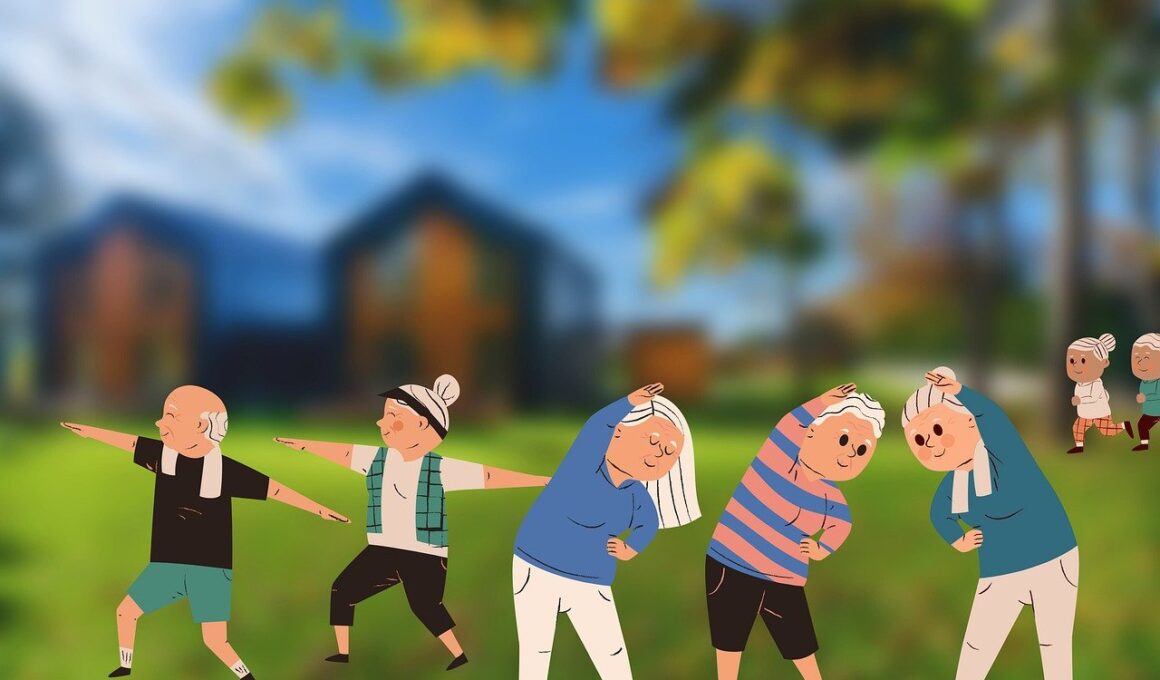Advancements in Personalized Fitness Programs for the Elderly
The aging population is increasingly gravitating towards personalized fitness programs, tailored to meet their unique physical needs. Recent research highlights that these customized plans can significantly improve both physical and mental health among the elderly. Fitness programs designed specifically for older adults consider various factors, such as current health conditions, previous exercise experience, and personal fitness goals. Moreover, instructors trained in elderly care can modify activities to ensure safety while maximizing benefits. These adjustments include low-impact aerobic exercises, strength training, and flexibility routines. According to studies, engaging in tailored fitness programs results in improved mobility, increased strength, and enhanced overall well-being. Furthermore, incorporating technology, like wearable devices, monitors real-time data providing immediate feedback and motivation. This approach not only helps in tracking progress but also fosters a sense of accountability. Personalization is key, as each older adult has different responses to exercise. Thus, understanding individual limitations and capabilities is vital. The future of fitness for seniors lies in this adaptable approach, ensuring that everyone can partake in an active lifestyle regardless of age or ability.
Continued advancements in technology have also revolutionized how fitness programs are structured and delivered to the elderly. Virtual fitness classes have emerged, allowing seniors to participate in group workouts from the comfort of their homes. These online platforms deliver customized workouts designed by professionals specializing in elderly fitness. Benefits are manifold; they include promoting social interaction, reducing isolation, and fostering community spirit among participants. Moreover, these digital solutions offer flexibility, enabling users to exercise at their convenience, thereby fitting into their other commitments. Research shows that consistent participation in these classes improves adherence to fitness regimens. The implementation of artificial intelligence is further personalizing experience; smart algorithms can recommend specific workouts based on individual performance data. This innovative approach not only makes exercise enjoyable but also ensures it remains safe. Options like adaptive exercise programs can modify difficulty levels according to real-time assessment of user capabilities. As the demand for individualized elderly fitness grows, it is essential for trainers to stay updated with the latest methodologies and adapt to evolving needs. Such proactive measures are crucial for enhancing quality of life through physical activity.
Importance of Social Interaction in Approach
Group fitness activities have been shown to yield substantial benefits for elderly participants. Not only do these activities promote physical health, but they also enhance mental health through social interaction. Engaging in exercise with peers creates supportive environments conducive to motivation and encouragement. Older adults often face challenges with isolation, so group settings offer opportunities to build friendships. In-person classes simulate camaraderie, leading to increased enthusiasm towards fitness goals. According to studies, older adults involved in group exercises are more likely to adhere to regular workout schedules. Classes designed for this demographic can include dance, yoga, or low-impact aerobics, all while ensuring safety protocols are followed. Additionally, trainers can create programs fostering teamwork, such as light-hearted competitions that promote a sense of belonging. Community centers or local gyms are pivotal in offering these group activities tailored for seniors, affirming the importance of connection among individuals. Thus, cultivating a supportive atmosphere, wherein participants encourage one another, leads to enhanced physical and psychological outcomes. As we advance, incorporating more community-driven approaches will only elevate the experiences and results of senior fitness programs.
Furthermore, research emphasizes the role of varied physical activities within tailored fitness programs. In contrast to monotonous exercise routines, incorporating diverse modalities leads to better engagement. Activities such as swimming, gardening, or tai chi can significantly increase participation rates among elderly individuals. Research indicates that incorporating different types of exercises helps reduce boredom while maximizing the physical benefits. Older adults tend to be more physically active when exercises encompass enjoyment alongside health improvement. Moreover, accessing successful fitness demonstrations can inspire participation. Many experts advocate for including recreational facilities that encourage seniors to explore different activities. Tailored fitness programs are designed to be adaptable; thus, providing multiple choices fosters autonomy and empowers seniors. As research continues to emerge, it reaffirms the necessity for ongoing education in fitness programming. Public policies need recognition of such frameworks to include funding and resources for diverse fitness programs focused on elderly populations. Personalized fitness will undoubtedly pave the way for healthier aging experiences, allowing seniors to enjoy enhanced lifestyles filled with movement, strength, and vitality. Bridging gaps and catering to unique needs will serve to improve overall wellness.
The Role of Nutrition in Fitness Programs
Simultaneously, nutrition must be recognized as a crucial component of personalized fitness programs. An effective fitness strategy for older adults is incomplete without considering dietary needs. Research suggests that a balanced diet enhances physical performance while helping achieve fitness goals. Professionals now advocate for creating synergy between healthy eating habits and exercise regimens. For instance, focusing on protein intake is essential to maintain muscle mass, especially as individuals age. Moreover, advice on hydration is crucial, given that older adults may not instinctively feel thirsty. As part of personalized fitness approaches, nutritionists, and trainers collaborate to produce tailored meal plans for participants. This integration ensures the elderly are consuming enough nutrients that support their training efforts. Activities such as cooking workshops can also educate seniors about meal preparation. Engaging with nutrition goes hand in hand with exercise, amplifying effectiveness. At the same time, increased focus on nutrition also leads to healthier lifestyle choices overall. Ultimately, acquiring good nutrition knowledge empowers seniors, providing them with the tools necessary to successfully navigate the intersections of fitness and healthier living. This holistic approach makes a tangible impact on their quality of life.
Moreover, regular assessments are vital for ensuring the effectiveness of personalized fitness programs for seniors. As these programs evolve, tailoring them according to individual progression becomes increasingly essential. Fitness assessments, which can include evaluations of strength, flexibility, balance, and endurance, provide valuable information for adjusting routines. This continuous progress tracking helps differentiate successful strategies from ineffective ones. Additionally, maintaining open communication between trainers and participants fosters a productive environment conducive to growth. Regular feedback helps trainers modify programs, ensuring alignment with clients’ capabilities and aspirations. By using data collected from wearable devices or health apps, trainers can tailor programs to enhance performance. Implementing such strategies inspires confidence while ensuring each senior continues to enjoy their exercise journey. Moreover, understanding that aging is a dynamic process assists in eliciting realistic expectations for participants. Trainers must remain adaptable and responsive to changes affecting health statuses, ensuring inclusivity where possible. These efforts result in sustainable improvements among various fitness levels, allowing seniors to thrive confidently in fitness programs. Continuous assessment ultimately plays a pivotal role in paving the way for their success.
Future Directions in Fitness Programs for Seniors
Looking ahead, the future of personalized fitness programs for seniors appears promising, bolstered by growing awareness of their importance. Innovations in research and technology will continue to drive effective strategies tailored for elderly populations. Moreover, as demographic changes expand the elderly population, the need for adaptable programs focused on enhancing quality of life rises. Collaborations among fitness professionals, healthcare providers, and technology experts can cultivate new methodologies vital for meeting diverse needs. Community engagement becomes critical, promoting awareness regarding available fitness options among older adults. Such initiatives help build networks, thus ensuring accessibility to fitness programs. Also, educating the wider public on the benefits of physical activity can incentivize seniors to prioritize their fitness. As the fitness industry evolves, opportunities for offering mentorship and specialized courses will emerge, training the next generation of trainers dedicated to elderly fitness. Ultimately, embracing the concept of personalized fitness can foster sustainable change in lifestyle choices impacting seniors’ overall well-being. A commitment to innovation guarantees seniors lead healthier, more active lives as they age. Collectively, these advancements will create lasting effects in thriving communities of older adults.
Finally, assessing the impacts of personalized fitness programs on the elderly’s psychosocial health is paramount. With increased social connection and physical activity, participants often report enhancements in their overall mental well-being. Studies underscore the link between regular exercise, reduced stress, improved mood, and greater cognitive function in older adults. Initiating programs that encourage friendships and provide emotional support not only enrich fitness experiences but also enhance psychological resilience. Consequently, these approaches help combat feelings of loneliness common among seniors. Individual gains in self-esteem correlated with improved physical capacity are notable outcomes from such tailored approaches. Therefore, including a holistic perspective on outcomes proves essential for evaluating overall effectiveness. Exploring correlations between physical activity, mental health, and social engagement presents new opportunities for future research. As knowledge expands, trainers must integrate these insights into fitness frameworks tailored for older adults. The connection between physical health and mental well-being will undoubtedly shape how programs are designed. Thus, fostering environments that prioritize social interactions alongside physical fitness will greatly enhance the senior experience. In sum, evaluating the entire spectrum of impacts will produce refined methods for effectively serving older adults in fitness realms.


